Downtown District
Bremond
101 Bremond
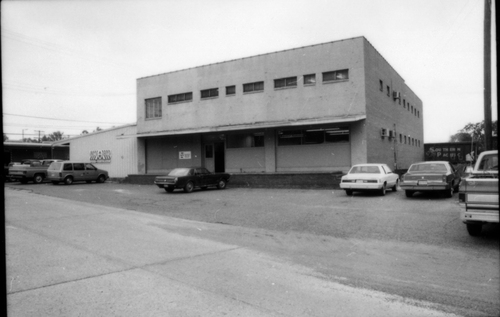

2011 Summer Survey
101 Bremond is found on the 1921 Sanborn Map of Nacogdoches Sheet 1 and the 1922 Sanborn Map of Nacogdoches Sheet 4. Both maps are found in the UT Perry-Castenada Collection.
1986 Survey Information
- Address: 101 Bremond
- Name: Nacogdoches Advertising Association
- Date: 1900-1920
- Block: 43
- Condition: Good – Fair
- Description: 2-story; load-bearing brick; masonry foundation; rectangular plan; 3-bay facade with suspended canopy, storefront filled in with plywood, narrow band of windows, double entry doors wood paneled with upper glass; flat roof with tile coping; brick loading dock; small steelframe windows at second floor.
- Significance: Adjacent to railroad.
Church
106 N Church

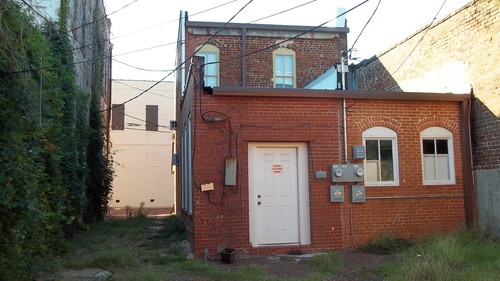
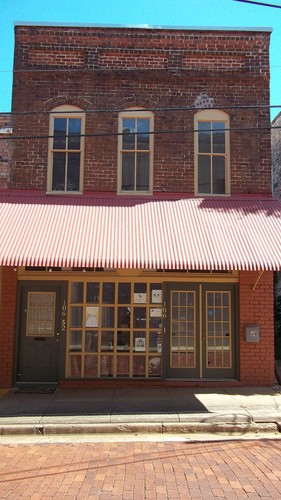
2012 Survey
Click here to access the 2012 Survey Form.
2007 National Register Information
- Address: 106 N. Church
- Previous Name: Bailey Block
- Date: 1900
- Type: Two part
- Contributing: Yes
1986 Survey Information
- Address: 106 N. Church
- Date: 1900
- Block: 7
- Lot: 13
- Condition: Fair
- Description: 2-story brick rectangular commercial structure with flat roof; segmented arches and replacement aluminum windows at second floor; wood and glass panel entry doors; inset panels and corbeled cornice; new sheet metal awning shared with buildings to the north.
- Significance: Shown on the 1912 Sanborn Fire Insurance Map as 2-story brick with awning, occupied as furniture storage and connected with 2-story frame structure (site #169).
107 S Church
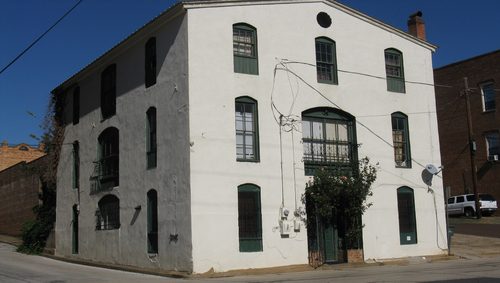
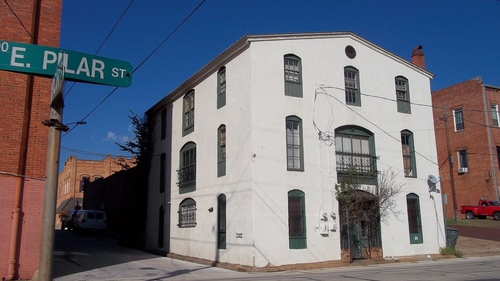
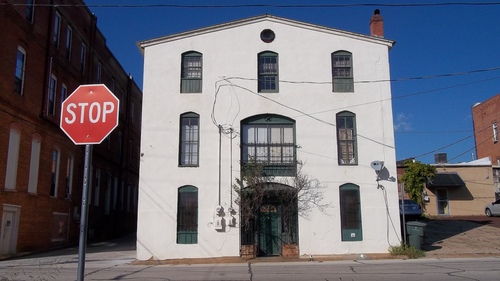
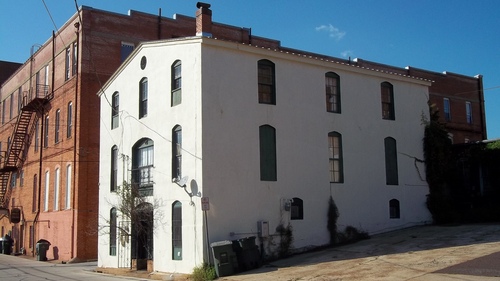
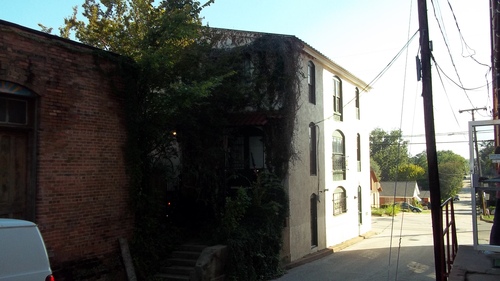
2012 Survey
Click here to access the 2012 Survey Form.
1986 Survey Information
- Address: 107 S. Church
- Name: Gallery 107
- Date: 1900
- Block: 16
- Lot: 7
- Condition: Fair; some alterations
- Description: 3-story rectangular brick commercial structure with gable sheet metal roof; exterior stuccoed; brick chimney at southeast comer; 6/6 double-hung windows with segmental arches.
- Significance: Shown on 1912 Sanborn Fire Insurance Map as a 2-story brick with basement and 2-story frame addition on north side; used a shoe repair, warehouse, and laundry.
108 N Church
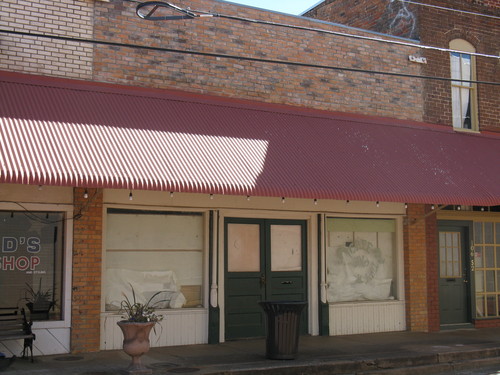
2010 Survey
Click here to access the 2010 Survey Form.
2007 National Register Information
- Address: 108 N. Church
- Previous Name: Bailey Block
- Date: 1900
- Type: One Part
- Contributing: Yes
1986 Survey Information
- Address: 108 N. Church
- Name: Bartol & Perley Investigators
- Date: 1900
- Block: 7
- Lot: 12
- Condition: Fair
- Description: 1-story rectangular brick commercial structure with flat roof; inset panels on stuccoed facade; sheet metal awning shared with neighboring buildings; wood and plate glass windows and wood and glass paneled entry doors flanked by blind turned posts.
- Significance: Shown on the 1912 Sanborn Fire Insurance Map as a 1-story brick with frame awning; used as a print shop with electric motor; a gasoline engine was not in use.
110 N Church
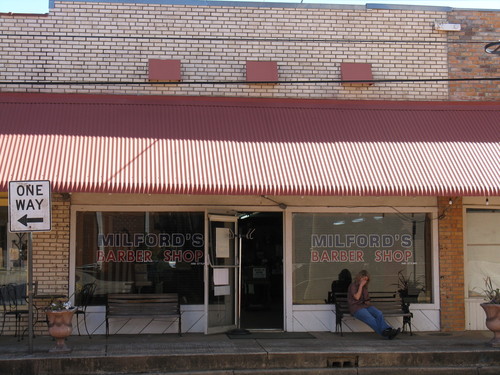
2010 Survey
Click here to access the 2010 Survey Form.
2007 National Register Information
- Address: 110 N. Church
- Name: Milford’s Barber Shop
- Previous Name: Bailey Block
- Date: 1900
- Type: One part
- Contributing: Yes
1986 Survey Information
- Address: 110 N. Church
- Date: 1910
- Block: 7
- Lot: 10
- Condition: Fair
- Description: 1-story rectangular brick commercial structure with flat roof; tile coping; metal awning on southern part; stepped parapet; wooden awning on northern part; lights above awnings closed off on most fronts or hidden by sheet metal awnings; some 12-light entry doors; 1 plate glass windows.
- Significance: Shown on the 1912 Sanborn Fire Insurance Map as 1-story brick with frame awning, used as garage/auto repair, feed warehouse, and black restaurant.
112 N Church
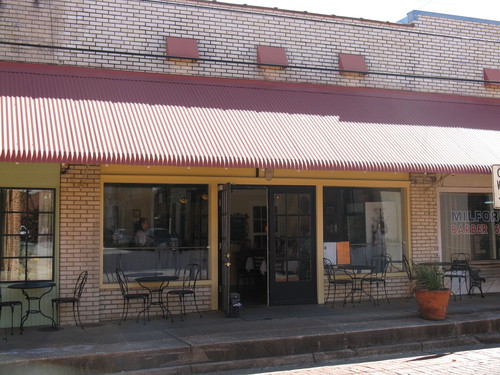
2010 Survey
Click here to access the 2010 Survey Form.
2007 National Register Information
- Address: 112 N. Church
- Name: Vacant
- Previous Name: Bailey Block
- Date: 1900
- Type: One part
- Contributing: Yes
1986 Survey Information
- Address: 112 N. Church
- Date: 1910
- Block: 7
- Lot: 10
- Condition: Fair
- Description: 1-story rectangular brick commercial structure with flat roof; tile coping; metal awning on southern part; stepped parapet; wooden awning on northern part; lights above awnings closed off on most fronts or hidden by sheet metal awnings; some 12-light entry doors; 1 plate glass windows.
- Significance: Shown on the 1912 Sanborn Fire Insurance Map as 1-story brick with frame awning, used as garage/auto repair, feed warehouse, and black restaurant
113 N Church
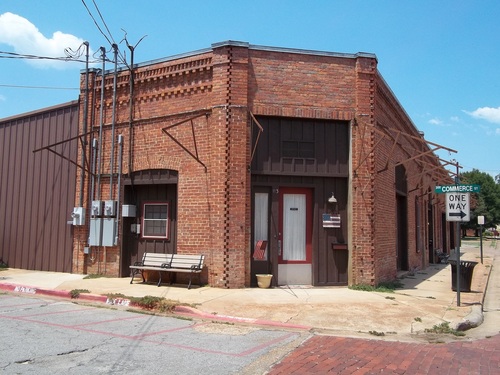

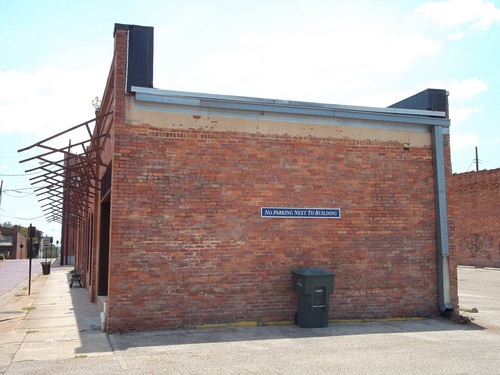
2012 Survey
Click here to access the 2012 Survey Form.
1986 Survey Information
- Address: 117 N. Church
- Date: 1910
- Block: 7
- Lot: 10
- Condition: Fair
- Description: 1-story rectangular brick commercial structure with flat roof; tile coping; metal awning on southern part; stepped parapet; wooden awning on northern part; lights above awnings closed off on most fronts or hidden by sheet metal awnings; some 12-light entry doors; 1 plate glass windows; 118 N. Church is 2-story with stepped parapet; flat roof; windows and doors replaced with aluminum units; front closed off with board and batten; entry to 118 has fluted pilasters and molded cornice.
- Significance: Shown on the 1912 Sanborn Fire Insurance Map as 1-story brick with frame awning, used as garage/auto repair, feed warehouse, and black restaurant.
114 N Church
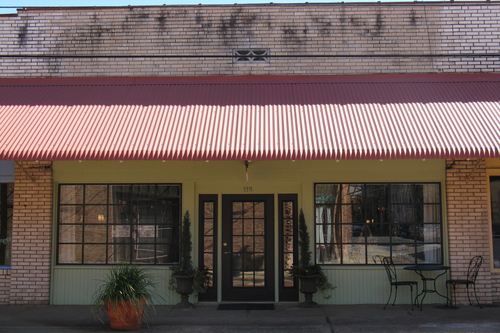
2010 Survey
Click here to access the 2010 Survey Form.
1986 Survey Information
- Address: 114 N. Church
- Date: 1910
- Block: 7
- Lot: 10
- Condition: Fair
- Description: 1-story rectangular brick commercial structure with flat roof; tile coping; metal awning on southern part; stepped parapet; wooden awning on northern part; lights above awnings closed off on most fronts or hidden by sheet metal awnings; some 12-light entry doors; 1 plate glass windows.
- Significance: Shown on the 1912 Sanborn Fire Insurance Map as 1-story brick with frame awning, used as garage/auto repair, feed warehouse, and black restaurant
116 N Church
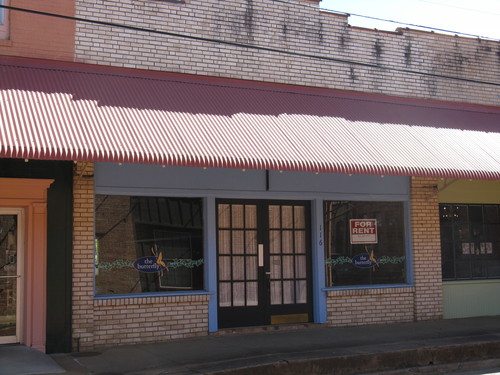


2012 Survey
Click here to access the 2012 Survey Form.
2007 National Register Information
- Address: 116 N. Church
- Name: Cottage Kitchen Shop
- Previous Name: Bailey Block
- Date: 1900
- Type: One part
- Contributing: Yes
1986 Survey Information
- Address: 116 N. Church
- Date: 1910
- Block: 7
- Lot: 10
- Condition: Fair
- Description: 1-story rectangular brick commercial structure with flat roof; tile coping; metal awning on southern part; stepped parapet; wooden awning on northern part; lights above awnings closed off on most fronts or hidden by sheet metal awnings; some 12-light entry doors; 1 plate glass windows.
- Significance: Shown on the 1912 Sanborn Fire Insurance Map as 1-story brick with frame awning, used as garage/auto repair, feed warehouse, and black restaurant.
118 N Church
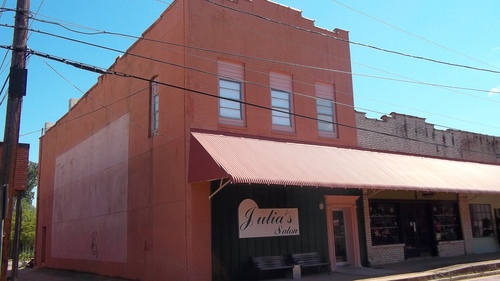
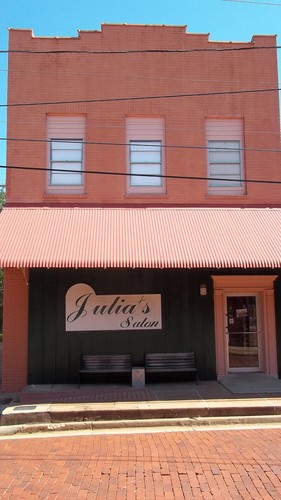

2012 Survey
Click here to access the 2012 Survey Form.
2007 National Register Information
- Address: 118 N. Church
- Name: The Old Warehouse
- Previous Name: Bailey Block
- Date: 1900
- Type: One part
- Contributing: Yes
1986 Survey Information
- Address: 118 N. Church
- Date: 1910
- Block: 7
- Lot: 10
- Condition: Fair
- Description: 2-story with stepped parapet; flat roof; windows and doors replaced with aluminum units; front closed off with board and batten; entry to 118 has fluted pilasters and molded cornice.
- Significance: Shown on the 1912 Sanborn Fire Insurance Map as 1-story brick with frame awning, used as garage/auto repair, feed warehouse, and black restaurant.
122 N Church
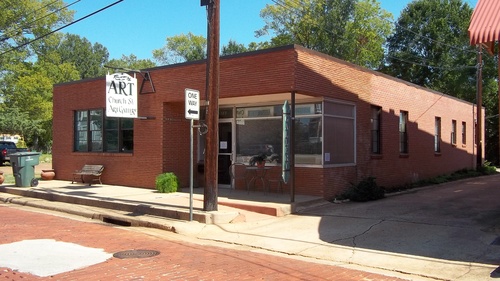

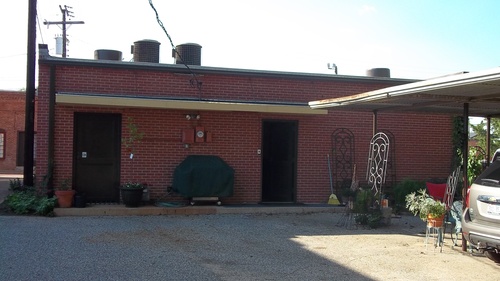
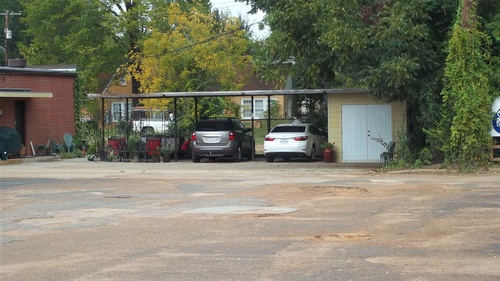
2012 Survey
Click here to access the 2012 Survey Form.
2007 National Register Information
- Address: 122 N. Church
- Name: Julia’s Salon
- Previous Name: Bailey Block
- Date: 1900
- Type: Two part
- Contributing: No
Note – it appears that this information belonged to 118 N. Church since the next entry is 1xx N. Church and matches this structure. (PB 12/26/12)
1986 Survey Information
- Address: 122 N. Church
- Name: La Merle K. Hunt Building
- Date: 1958
- Block: 7
- Lot: 9
- Condition: Good
- Description: 1-story rectangular brick commercial structure with flat roof; metal double-hung windows and plate glass windows.
- Significance: Shown on the 1912 Sanborn Fire Insurance Map as two parts, 1-story and 2-story brick buildings; the 1-story portion was vacant, roof destroyed by fire; the 2-story portion was a black barber shop and clothes presser.
141 N Church
/imgs/141_N_Church_1.jpg)
/imgs/141_N_Church_2.jpg)
/imgs/141_N_Church_3.jpg)
/imgs/141_N_Church_4.jpg)
/imgs/141_N_Church_5.jpg)
To view the independent National Register of Historic Places information for this building, click here.
2012 Survey
Click here to access the 2012 Survey Form.
2007 National Register Information
- Address: 141 N. Church
- Name: Jones House Bed & Breakfast
- Previous Name: Jones House
- Date: 1895
- Type: Domestic
- Contributing: Yes
1986 Survey Information
- Address: 141 N. Church
- Name: John Square Office
- Date: 1890
- Block: 8
- Lot: 8
- Condition: Good; recently renovated and painted; trees south of house removed for parking lot
- Description: 2-1/2 story irregular plan frame residential structure with hipped composition shingle roof; hexagonal tower on northeast corner; two-story porch is heavily ornamented on the Eastlake style with extensive use of balls and spindles, turned posts, shouldered depressed arch brackets, friezes, half-moon bay dividing front steps, ornamented overdoors and brackets; clapboard siding; butt-cut and houndstooth shingles on gable ends; dormers have gable roof and sawn bargeboards; large brick interior chimney; pent skirts, shingles, between stories on tower; projecting bay on south facade has chamfered bay at first level, curved bay with curved 1/1 double-hung windows at second; 1/1 double-hung windows, some Queen Anne; tall 1/1 double-hung windows open onto second floor porch; one circular window on first floor porch; north facade has projecting circular bay at first level, chamfered bay above.
- Significance: Recorded Texas Historic Landmark (RTHL); excellent example of style in East Texas; shown on the 1912 Sanborn Fire Insurance Map as a 2-story frame residence with 3-story tower; large frame out-building at southwest corner of lot; removal of trees on south side isolates structure amid parking lots and reduces the once residential character of the structure.
1986 Survey Information
- Address: 141 N. Church
- Name: John Square Office
- Date: 1890
- Block: 8
- Lot: 8
- Condition: Good; recently renovated and painted; trees south of house removed for parking lot
- Description: 2-1/2 story irregular plan frame residential structure with hipped composition shingle roof; hexagonal tower on northeast corner; two-story porch is heavily ornamented on the Eastlake style with extensive use of balls and spindles, turned posts, shouldered depressed arch brackets, friezes, half-moon bay dividing front steps, ornamented overdoors and brackets; clapboard siding; butt-cut and houndstooth shingles on gable ends; dormers have gable roof and sawn bargeboards; large brick interior chimney; pent skirts, shingles, between stories on tower; projecting bay on south facade has chamfered bay at first level, curved bay with curved 1/1 double-hung windows at second; 1/1 double-hung windows, some Queen Anne; tall 1/1 double-hung windows open onto second floor porch; one circular window on first floor porch; north facade has projecting circular bay at first level, chamfered bay above.
- Significance: Recorded Texas Historic Landmark (RTHL); excellent example of style in East Texas; shown on the 1912 Sanborn Fire Insurance Map as a 2-story frame residence with 3-story tower; large frame out-building at southwest corner of lot; removal of trees on south side isolates structure amid parking lots and reduces the once residential character of the structure.
Commerce
300 E Commerce
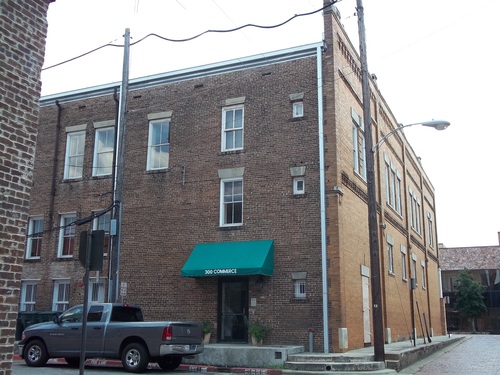
2010 Survey
Click here to access the 2010 Survey Form.
301 E Commerce
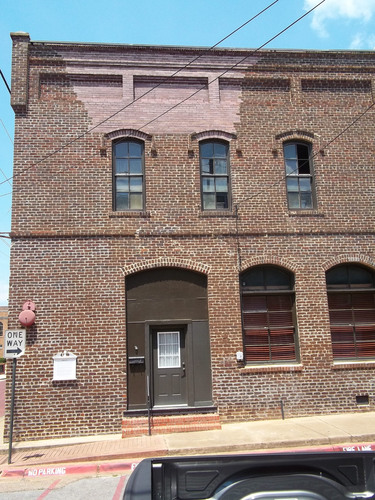


2010 Survey
Click here to access the 2010 Survey Form.
2007 National Register Information
- Address: 301 E. Commerce
- Name: Bowers Overhead Door Company
- Previous Name: Cotton Exchange / Mast Office
- Date: 1898
- Type: Two part
- Contributing: Yes
305 E Commerce
/imgs/305_E_Commerce_1.jpg)
/imgs/305_E_Commerce_2.jpg)
This building is known as the Old Cotton Exchange Building. To see its registration on the National Register of Historic Places, click here.
2010 Survey
Click here to access the 2010 Survey Form.
2007 National Register Information
- Address: 305 E. Commerce
- Name: Bowers Overhead Door Company
- Previous Name: Cotton Exchange / Mast Office
- Date: 1898
- Type: Two part
- Contributing: Yes
1986 Survey Information
- Address: 305 E. Commerce
- Date: 1900
- Block: 8
- Lot: 3
- Condition: Good; some windows are blocked in; some alterations
- Description: 2-story rectangular brick commercial structure with flat roof; 4/4 double-hung windows set in openings with segmental arches outlined at second level by projecting headers laid in stilted arches connected by a double header course; arched entry has wood and glass panel double door; corbeled string courses at cornice; fan-shaped pediment at roof line over entry is flanked by stopped pilasters capped with curved brick finials.
- Significance: Shown on 1912 Sanborn Fire Insurance Map as 2-story brick with wraparond frame awning; freight elevator at rear; used as dry goods warehouse; partition on rust floor only.
309 E Commerce

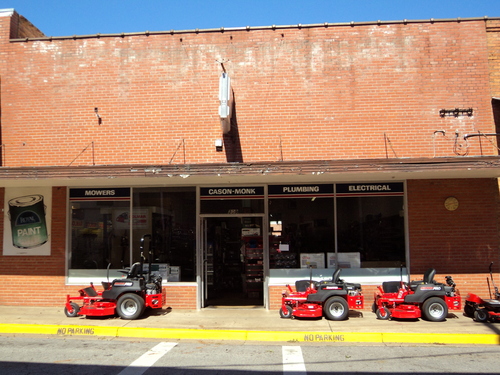
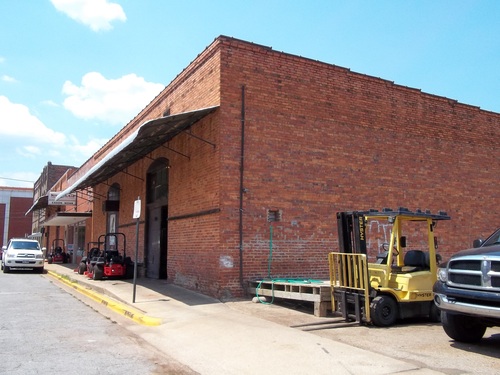

2010 Survey
Click here to access the 2010 Survey Form.
2007 National Register Information
The 2007 National Register Nomination has this listed as three structures on Commerce (without numbers) all of which are contributing. The first constructed in 1896, the second in 1950, and the third in 1910.
1986 Survey Information
- Address: 309 E. Commerce
- Date: 1900
- Block: 8
- Lot: 5 and 6
- Condition: Good
- Description: 1-story rectangular brick commercial structure with flat roof; tile coping; metal and plate glass doors and windows; structure appears to be infill between buildings to its east and west; openings (closed) to east of entrance, and type of brick, match building to the west; flat metal awning on west side; old steel and sheet metal curved awning on east side.
- Significance: Shown on the 1912 Sanborn Fire Insurance Map as 1-story brick with frame awning; used as hardware and implements warehouse.
Fredonia
116 N Fredonia
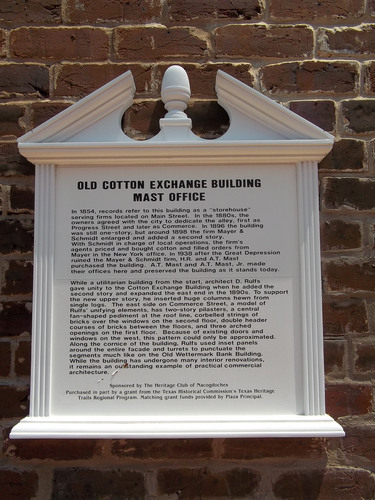
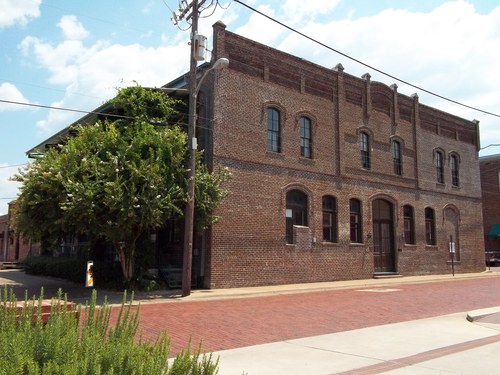
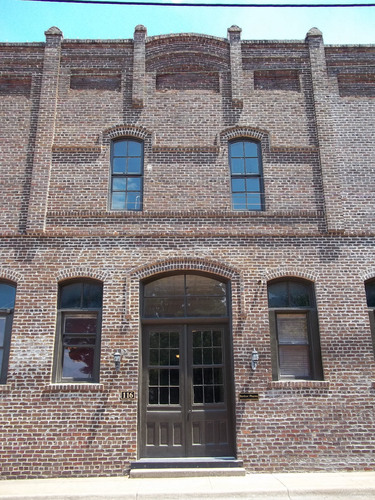
This building is part of the Old Cotton Exchange Building (305 Commerce). To see its registration on the National Register of Historic Places, click here.
2010 Survey
Click here to access the 2010 Survey Form.
125 N Fredonia
As of survey in September 2012, this property was inaccessible – interior entrance.
129 N Fredonia

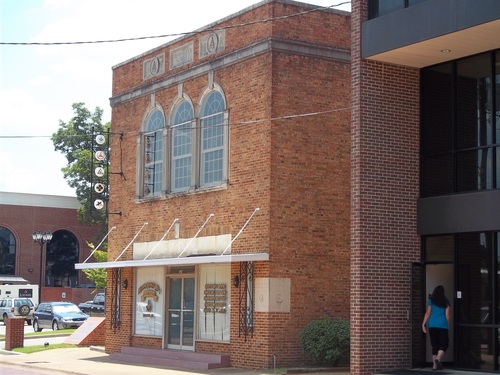

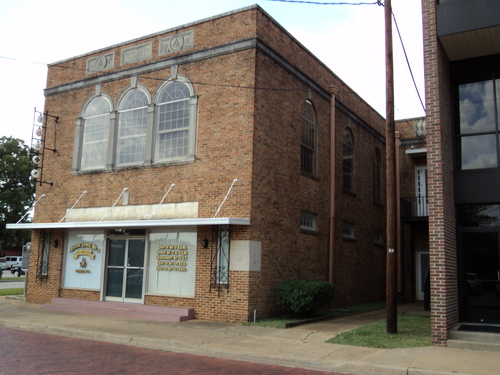
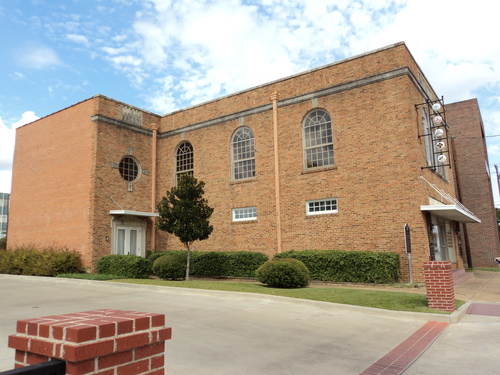
2010 Survey
Click here to access the 2010 Survey Form.
2007 National Register Information
- Address: 125 N. Fredonia
- Name: Milam Lodge No. 2
- Previous Name: Milam Lodge No. 2
- Date: 1931
- Type: Two part
1986 Survey Information
- Address: 129 N. Fredonia
- Date: 1931
- Block: 9
- Lot: 5-B
- Condition: Good
- Description: 2-story ell-shaped brick structure with flat roof; tile coping; altered entry of metal and plate glass doors and windows protected by modern metal awning; second story has three arched windows with I5-light operating sashes, keyed arches, compound architrave separated by fluted pilasters; cast stone molding below cornice; stone panels with Masonic emblems above molding read, left to right, “1837,” “Milam Lodge No.2,” and “1931.”
- Significance: The 1912 Sanborn Fire Insurance Map shows a 2-story brick structure with frame awning; BPOE Lodge and second floor warehouse and print shop on first floor; this structure may been built in 1931 as indicated on cast stone ornamentation.
135 N Fredonia
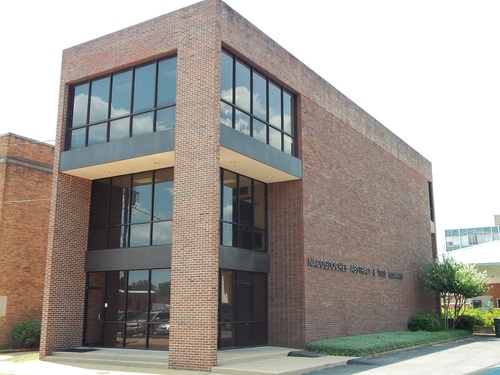
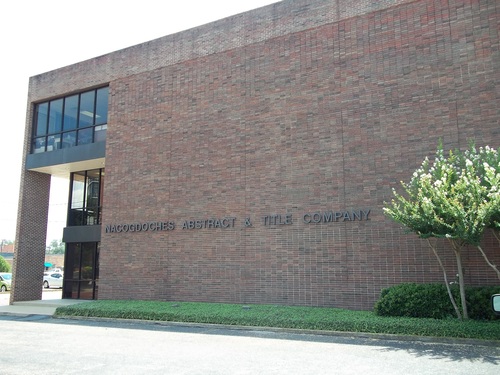
2012 Survey
Click here to access the 2012 Survey Form.
1986 Survey Information
- Address: 135 N. Fredonia
- Date: 1980
- Block: 9
- Lot: 4
- Condition: Excellent
- Description: 3-story rectangular brick commercial structure with flat roof; inset entry and second floor above with tinted plate glass windows.
200 N Fredonia
/imgs/200_N_Fredonia_1.jpg)
/imgs/200_N_Fredonia_2.jpg)
/imgs/200_N_Fredonia_3.jpg)
/imgs/200_N_Fredonia_4.jpg)
2010 Survey
Click here to access the 2010 Survey Form.
2007 National Register Information
- Address: 200 N. Fredonia
- Name: Hotel Fredonia
- Date: 1953
- Type: Two part
- Contributing: Yes
Architect: J. N. McCammon
Builder: W. S. Bellows Construction Company
Interior Design: Titche-Goettinger (Dallas)
Original Furniture: Phoenix Chair Company (Sheboygan, Wis.)
Formal opening: April 1, 1955
Oak Terrace Addition: 1960, McCammon
The six-story Hotel Fredonia is characterized by its slab-like tower surrounded by a one-story semi-circular wing that houses cabana suites, and wraps around an interior courtyard and swimming pool. Later additions include a 30-unit two-story Oak Terrace addition to the northeast end of the property, and one to one-and-a-half story conference facility to the rear of the main hotel complex. The primary façade of the original hotel diagonally faces southeast onto Hospital Street. The ground floor is clad in brick, and is marked by a porte-cochere. It is surmounted by five floors, each comprised of horizontal ribbon windows divided vertically into eight asymmetrically arranged bays. This southeast facade, and each unit within the overall composition, is framed with elaborate green-tinged ironwork, often described as “New Orleans style.” With the exception of large expanses of glass and ironwork details, the exterior is clad in red brick, left unpainted and generally unadorned. The primary entrance on the ground level is indicated by the porte-cochere which shelters the entry to the main lobby; other entrances penetrate the semicircular one-story wing, and these lead to the interior courtyard. The Oak Terrace is accessed from the northeast side of the property, off of Church Street. Despite its smaller scale and “motel” configuration, materials and details mirror that of the original building. The conference facility toward the north end of the property is a windowless monolith clad in red brick, and although large, has been skillfully tucked behind the hotel tower and does not visually compete. This hotel remains the tallest building in the downtown district.
The Hotel Fredonia not only represents the success of a community-supported economic development effort, but is a rare local example of a modified and small-scale International Style building. The main tower, slab-like in its massing, recalls work by many notable world-renowned modernists architects in this same period, such as the United Nations Secretariat Building in New York (1952).
The Hotel Fredonia was constructed in 1954-55 at 200 North Fredonia, between Hospital and Arnold Streets. Built on the site of the former First Christian Church, a rooming house and several private residences, The Hotel Fredonia was positioned at the north end of the commercial district, directly across from the passenger bus depot. The hotel vied for tenants with nearby hotels such as the Liberty (on the plaza principal). The name for this impressive six-story, one hundred room hotel was taken from the Fredonia Rebellion of 1826 in which Haden Edwards and a group of settlers declared Nacogdoches independent from Mexico. Although the insurgency failed, it represented the vast ambitions of the small town and the character of its citizens, as the hotel was meant to do a century later.
Since the late 1940s, Nacogdoches boosters had been investigating the possibility of building a community-owned hotel and conference center as a draw for regional tourism and business meetings. The local Chamber of Commerce had long believed that the town was losing thousands of dollars per year in potential tourist income, and blamed the lack of accommodations in the region that could service both leisure travelers and pass-through business travelers. In 1952, the need for improved guest facilities in the area had become clear. In an effort to boost the economy while simultaneously adding prestige to the city, a group of businessmen formed the New Hotel Campaign for Nacogdoches, later re-named the Nacogdoches Community Hotel Corporation. Led by Jack McKinney (McKinney Drilling Company), J.
Elbert Reese, and R.O. Muckleroy, they began to sell stock to citizens in order to finance the project. They employed Hockenbury System, Inc., from Harrisburg, Pennsylvania, who were specialists in hotel fundraising. This group survey the need for a hotel, and recommended a fund-raising campaign that would included the sale of stock was sold in units of $100, “consisting of one share of common stock valued at $50 and one $50 bond yielding 4 per cent interest yearly.” The Hockenbury company believed that “big investors” would contribute the vast majority of the funding, but in the end, it was the “little men”of Nacogdoches who made over half of the stock purchases in $100 units. Approximately 1100 local businessmen invested, including figures such as Carl Monk who was also on the executive committee, with one individualcontribution equaling $10,000.
The total amount set aside for the construction of the hotel was $500,000. Land was acquired along Hospital Street between Fredonia and Mound, and plans were quickly developed. After a number of older buildings were demolished to make way for the new facility, the groundbreaking was held in 1954. Dallas architect J. N. McCammon – who later designed the Nacogdoches County Courthouse — was commissioned as the principal architect. The interiors were designed by Titche-Goettinger of Dallas, and murals were painted by the local artist Janet Turner. As with the architect and the interior design firm, a great deal of other design talent was recruited from Dallas: the swimming pool was designed by Paddock, and the kitchen equipped by Juey & Philip, also of Dallas. Tile for bathrooms, however, were imported from France. W.S. Bellows Construction Company of Houston, led by Frank Bellow, constructed the six-story building of reinforced concrete and brick cladding, accented with ”New Orleans” cast iron grillwork across the plate glass façade of the tower slab. The Hotel Fredonia was designed as a “modem contemporary-styled hotel building” entirely air-conditioned, and featured 100 rooms, conference facilities for 600, a patio and a kidney-shaped heated pool surround by semi-circle of cabana suites. With a coffee shop and guest parking for 100, the hotel covered an entire city block.
The Fredonia opened with much fanfare on 1 April 1955. An estimated 6,000 people attended the grand opening, and
press coverage of the event extended as far as both Dallas and Houston. The new building was held in high regard, both by its investors and the general public. Not only did it appear “as modern as an atomic submarine” but was viewed as “a hotel that would add prestige to any city in the world. To old Nacogdoches, standing waist deep in the glorious history of Texas, this great patio circled by smart-looking cabanas, is almost, yet not quite, incredible. It’s a little like having the Taj Mahal moved, stone by stone, from Agra to Lufkin.” Though the brick building was clearly viewed as both modern and functional- with clear reference to contemporary nationwide trends such as the International Style, yet McCammon added “enough traditional architecture in it to give the hotel a southern flavor and atmosphere along with its distinctive modern touch.”
For over a decade, between 1955 and 1967, The Hotel Fredonia was believed to be the most successful community owned hotel in the nation. In its first year alone, twenty-six conventions were scheduled. The achievement was recognized by Senate Resolution 212, sponsored by Senator Ottis E. Lock of Lufkin, which commended the citizens of Nacogdoches for uniting to build such a “fine” community hote1. By 1959, the hotel employed 92 people, and operated at 95.6% occupancy throughout the spring and fall months, with an average yearly income from rooms and food reaching $5,000,000.
So successful was the venture that they were able to expand, constructing the 30-unit Oak Terrace in 1960. The expansion program was estimated at $300,000, of which $50,000 was allocated for purchasing the lot to the north of the original facility. As with the original project, local citizens fronted the money for the real estate, and a bank loan was approved for the new building. In addition to providing new thirty new cabana units in a two-story motel configuration, the plans called for the addition of approximately 5,000 square feet of parking or space for 50 cars. J. N. McCammon of Dallas was again commissioned to design the hotel expansion.
The success of the Fredonia as a community hotel inspired the formation of Community Inns of America, Inc., led by Herbert Wilson, the manger of the Fredonia. The fledgling corporation hoped to provide consulting and planning services to communities nationwide who sought to create the same sort of facility that had be so successful in Nacogdoches. Along with the eight projects and twenty-three potential clients they advised in 1962, one of the most notable products to come of this new corporation was the film strip “The Hotel Fredonia Story,” which was filmed in color and shown throughout the United States and Canada to community groups interested in building their own community hotels.
Despite a tremendous first decade, the fortunes of the Fredonia began to decline in 1965, in part due to the influx of hotels both in Nacogdoches and in nearby Lufkin. Though 1963 proved to be a record year, and the hotel produced decent revenue in the following season, occupancy dropped to 88.9% in 1965. By 1968, the hotel faced financial difficulties and possibility of foreclosure with a debt of nearly $250,000. The Fredonia began looking for a buyer. It was eventually sold to Arthur Temple of Diboll, Texas for $325,000, “a near total loss” on the initial investment made by the community. Sheraton Hotels purchased the facility in 1970, and it was sold again in 1976. Troubles continued, and the hotel closed its door for four years beginning in 1985. In 1989, the Fredonia Corporation formed with the intent of funding a $4.2 million renovation, an estimate that was soon to expand to $7.5 million. Funds were raised by a combination of local stockholders- just as with the original construction project – with additional assistance from the Department of Urban Development Administration Grant program. The newly-remodeled Fredonia reopened in May 1989.
1986 Survey Information
- Address: 200 Fredonia St. North
- Date: 1952
- Condition: Good, plans to rehabilitate are on-going.
- Description: 6-story brick tower with flat roof surrounded by irregular plan one-story wings; porte cochere off lobby; symmetrical window arrangement of 1/1 panel flanking large center panel; extensive use of cast aluminum columns.
- Significance: Constructed by Arthur Temple and local citizens as hospitality center; closed due to poor management and high debts; may be rehabilitated in the next few years.
214 S Fredonia
/imgs/214_S_Fredonia_1.jpg)
/imgs/214_S_Fredonia_2.jpg)
/imgs/214_S_Fredonia_3.jpg)
/imgs/214_S_Fredonia_4.jpg)
2010 Survey
Click here to access the 2010 Survey Form.
2007 National Register Information
- Address: 214 S. Fredonia
- Name: Maria Davidson Apartments
- Date: 1928
- Type: Domestic
- Contributing: Yes
The Maria A. Davidson Apartments, designed by Dietrich Rulfs in 1928, is the only historic apartment building in Nacogdoches originally constructed for the purpose that it retains today. It also represents an intact example of a simplified Mission or Spanish Colonial Revival architectural style, which despite the Spanish heritage of Nacogdoches, is rarely seen in the extant building stock.
The Apartments are located one block south of the plaza principal, and face east onto South Fredonia Street. The facility occupies two lots that slope south toward Banita Creek. This is a 2-story, red brick building with an U-shaped plan. Designed by Dietrich Rulfs in 1928, this building stylistically recalls Mission Revival and Spanish Colonial Revivals popular in the United States in the from about 1890 into the 1920s. While this is a simplified version of revival style, it retains significant identifying features such as a red tile-clad hipped (or pent) roof cantilevered from the wall surface, and a roofline broken by a protruding Alamo parapet.
The primary façade of the apartment building faces east onto South Fredonia Street, with a secondary entrance through the courtyard on the south elevation. The east façade is composed of three bays. The central bay is slightly recessed, and the parapet above this bay projects beyond the roofline. The primary entry is positioned within this central bay, and is accessed by set of steps that culminate in small stoop, and the side rails have cast-stone coping. The double door entry is positioned at the top of the stairs, and is articulated by a brick archway. The door itself is a multi-light wood door, surmounted by a double row of transom windows and a filled arch (which may have been arched transom window, now filled over). The entry arch is flanked on each side by a 1/1 wood sash window, and second floor displays a centered set of paired sash windows (placed directly about the entryway), and flanked on each side by a 1/1 wood sash window. The central bay is flanked by identical and symmetrical wings to the north and south. The ground and second floors of each contain one set of paired 1/1 wood sash windows, with brick sills. The overall façade has little adornment, limited to a double row of solider bricks that form a string course just below the cornice line. Other ornamental detail is displayed at parapet, in the inset panel displaying building name, and in the decorative brackets under the eaves, very typical of Mission and Spanish Revival styles.
A second entry sequence is located on south elevation of building, which is marked by a small inset courtyard. Here, the building reads as two wings separated by the courtyard, which contains a double-height arcade allowing exterior access to the interior rooms. The arcade is placed at the rear (north end) of the courtyard, and is formed by a string of three connected arches, the center of which is wider and narrower than the outer two arches. All three are supported by square brick piers, embellished with corbelled brickwork at the spring of the arches. The arcade element is capped with an Alamo parapet, similar to the east facade. Like front of the building, the south doorway is reached by ascending a set of steps; here, one must first past beneath the arcade to reach the entry. Windows on both ground floor and second floor of this elevation show less regularity than on the east facade, with sets of paired sash windows and adjacent smaller single windows that likely view to bathroom facility. Sash windows also overlook the courtyard on both the ground and second floors.
Facilities for car parking include a paved lot to the south of the building (just off the courtyard), a 9-bay carport to the south which is contemporaneous with the apartment building, and a second non-original carport to the south.
John P. Davidson, who had a part in the formation of the First National Bank and commissioned Rulfs to design the Liberty Hotel in 1891 (which he owned until at least 1933) acquired lots on South Fredonia in 1927. Davidson had apparently been aware in statewide trends in apartment building – particularly the creation of smaller buildings consisting of four to twelve units meant to house middle-class occupants – and created his own version for Nacogdoches based on this prevalent model. The building was named for Davidson’s wife, Maria The structure originally housed single women who worked downtown as clerks, telephone operators, and in similar occupations.
The Maria Davidson Apartment building is listed on the National Register of Historic Places (1992) under Criterion C in the area of Architecture, and is associated with is associated with the context statement “Community Planning and Development in Nacogdoches: 1830-1940.”
1986 Survey Information
- Address: 214 S. Fredonia
- Date: 1910
- Block: 23
- Lot: 11 & 11-B
- Condition: Good
- Description: 2-story; load-bearing brick with brick foundation; U-plan with central hall; flat roof with parapets, at east and south entries a central mission-style parapet flanked by low parapets capped by bipped eaves, with Spanish tile and ornamental brackets; entry porches on east (arched opening without canopy) and south with two-story Palladian arched entry; windows 1/1 wood double-hung with double header course above at second floor, double doors wood with multipaned glass lights; exterior brick chimney on north facade; above east entry a concrete dedication plaque about Maria A. Davidson; basement under west half of building; 1-Story wood frame car garages, one is original with brick facade.
- Significance: Architectural.
Hospital
108 E Hospital
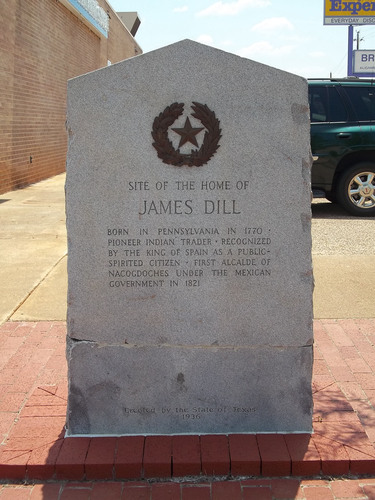
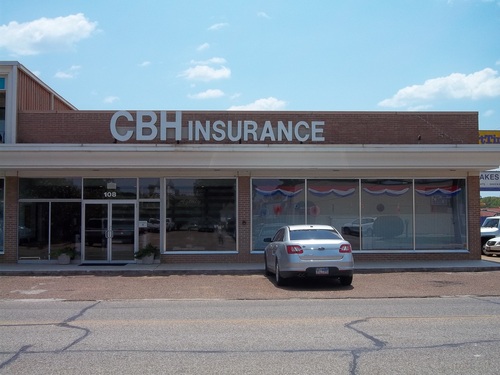
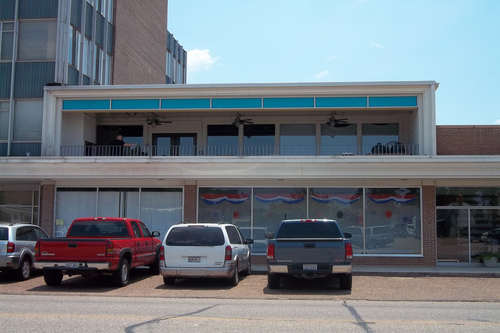
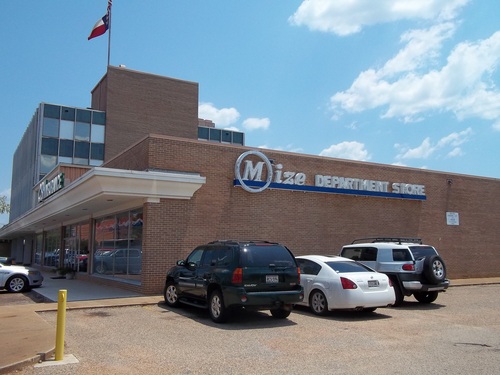
2010 Survey
Click here to access the 2010 Survey Form.
1986 Survey Information
- Address: 108 E. Hospital
- Date: 1965
- Block: 10
- Lot: 1-A
- Condition: Good
- Description: 1-1/2 story and 1-story rectangular brick commercial structure with flat roof; metal and plate glass doors and windows; covered walkway is continuous with that of Superior Savings (118 E. Hospital).
118 E Hospital
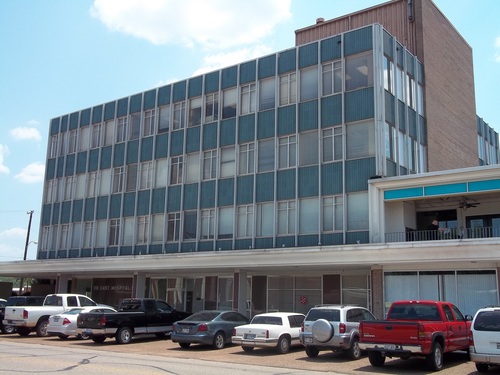
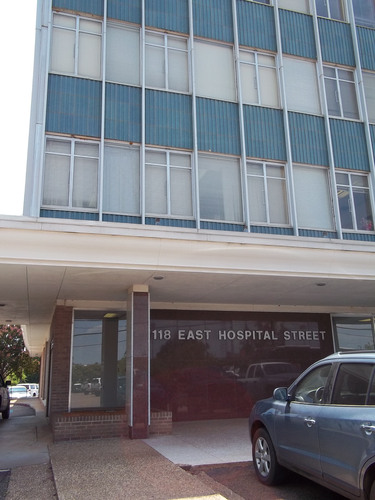

2012 Survey
Click here to access the 2012 Survey Form.
1986 Survey Information
- Address:118 E. Hospital
- Date:1965
- Block:10
- Lot:3
- Condition:Good
- Description:4-story rectangular glass masonry and metal commercial structure with flat roof; vertical metal members separate casement windows from fixed glass panels; horizontal bands of colored metal separate floors; masonry columns support a port cochere and covered drive-in, windows, and entry.
217 W Hospital
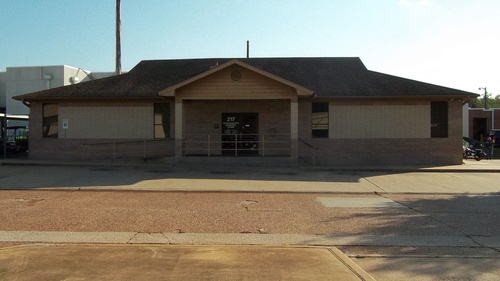
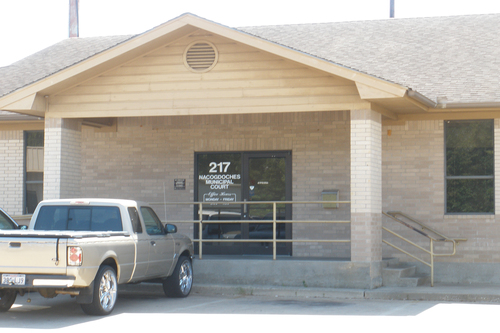
2012 Survey
This is the Nacogdoches Municipal Court. Click here to access the 2012 Survey Form.
2007 National Register Information
- Address: 217 W. Hospital
- Date: 1980
- Type: One part
- Contributing: No
310 E Hospital
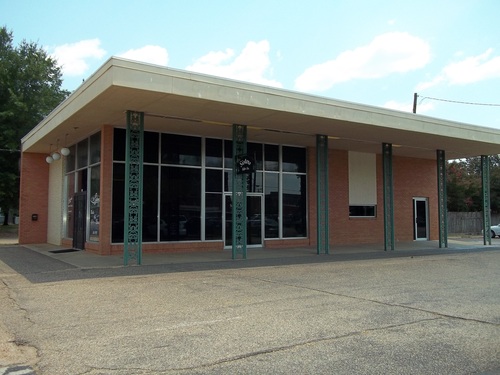
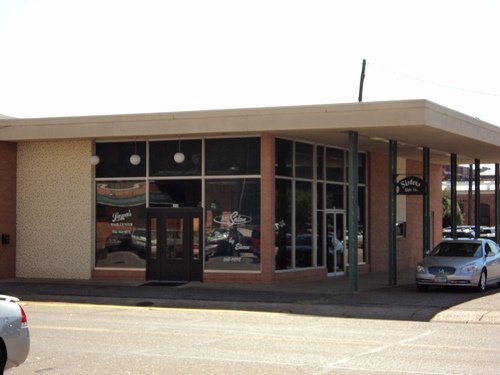
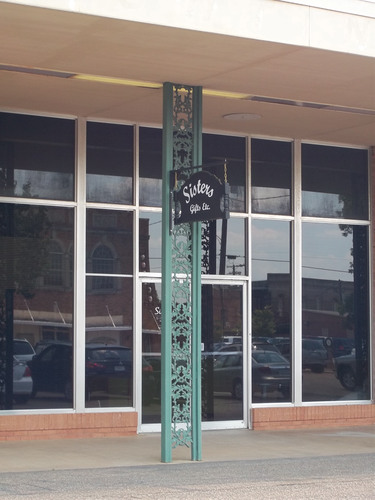
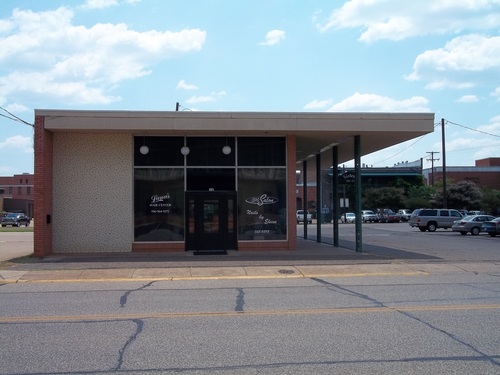
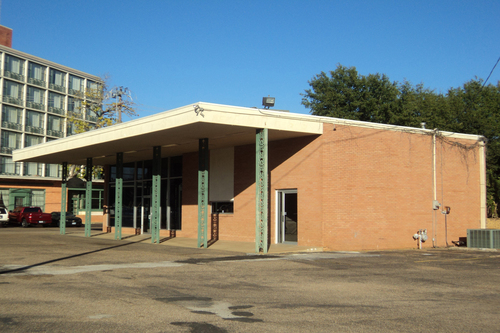
2010 Survey
Click here to access the 2010 Survey Form.
2007 National Register Information
- Address: 310 E. Hospital
- Name: Price Electronics
- Previous Name: Greyhound Bus
- Date: 1953
- Type: One part
- Contributing: Yes
1986 Survey Information
- Address: 310 E. Hospital
- Date: 1960
- Block: 8
- Lot: 2
- Condition: Good
- Description: 1-story rectangular brick commercial structure with flat roof; plate glass windows and doors; iron columns with filigree.
400 E Hospital
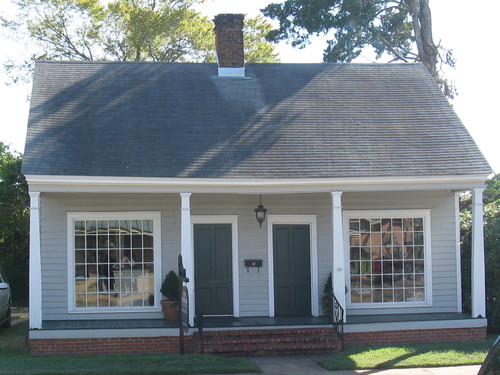
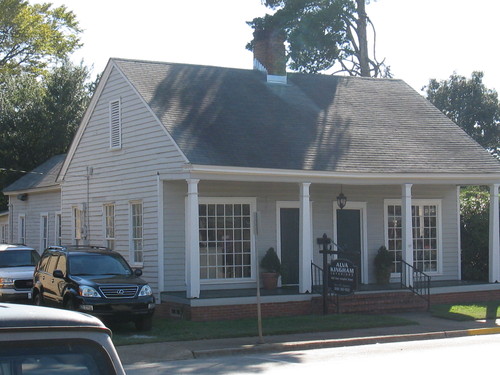
2010 Survey
Click here to access the 2010 Survey Form.
1986 Survey Information
- Address: 400 E. Hospital
- Date: 1880
- Block: 7
- Lot: 1-B
- Condition: Fair, windows altered on main facade.
- Description: 1-story rectangular frame residential structure with composition shingle gable roof; flat roof addition to rear; horizontal clapboard siding; 9/6 double-hung windows; hall parlor plan with raised panel entry doors off wood porch with battered box columns; replacement front windows of multipane fixed glass; corbeled brick chimney.
- Significance: Said to have been the Episcopal Church Rectory; may be older than 1880.
404 E Hospital
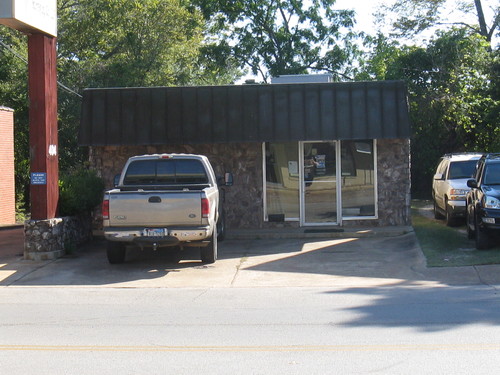
2010 Survey
Click here to access the 2010 Survey Form.
1986 Survey Information
- Address: 404 E. Hospital
- Date: 1970
- Block: 7
- Lot: 1-C
- Condition: Good
- Description: 1-story rectangular brick commercial structure with stone veneer front, flat roof; sheet metal awning; metal and plate glass entry door and side windows.
406 E Hospital
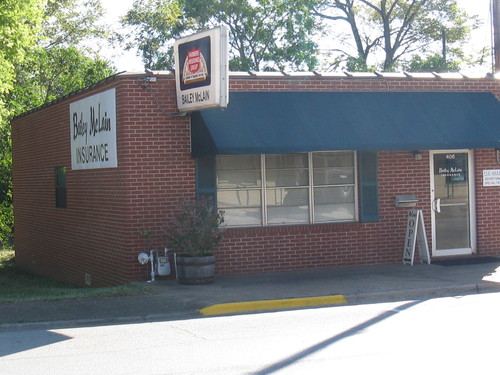
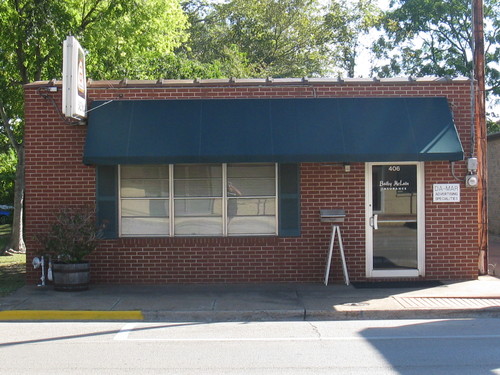
2010 Survey
Click here to access the 2010 Survey Form.
1986 Survey Information
- Address: 406 E. Hospital
- Date: 1940
- Block: 7
- Lot: 1
- Condition: Fair
- Description: 1-story brick rectangular commercial structure with flat roof; tile coping; metal windows; plate glass door.
422 E Hospital
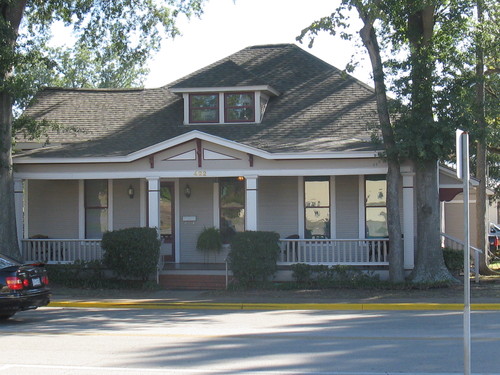

2010 Survey
Click here to access the 2010 Survey Form.
1986 Survey Information
- Address: 422 E. Hospital
- Date: 1910
- Block: 7
- Lot: 3-A
- Condition: Good
- Description: 1-story frame residential structure, rectangular, with composition shingle hip roof; pedimented gable with brackets over wood porch with box columns and plain balusters; horizontal bull-nosed siding; 1/1 double-hung windows; glass and wood panel entry door.
Lanana
106 N Lanana
2010 Survey
Originally built in 1860, Deidrich Rulfs remodeled it in 1890. Click here to access the 2010 Survey Form.
